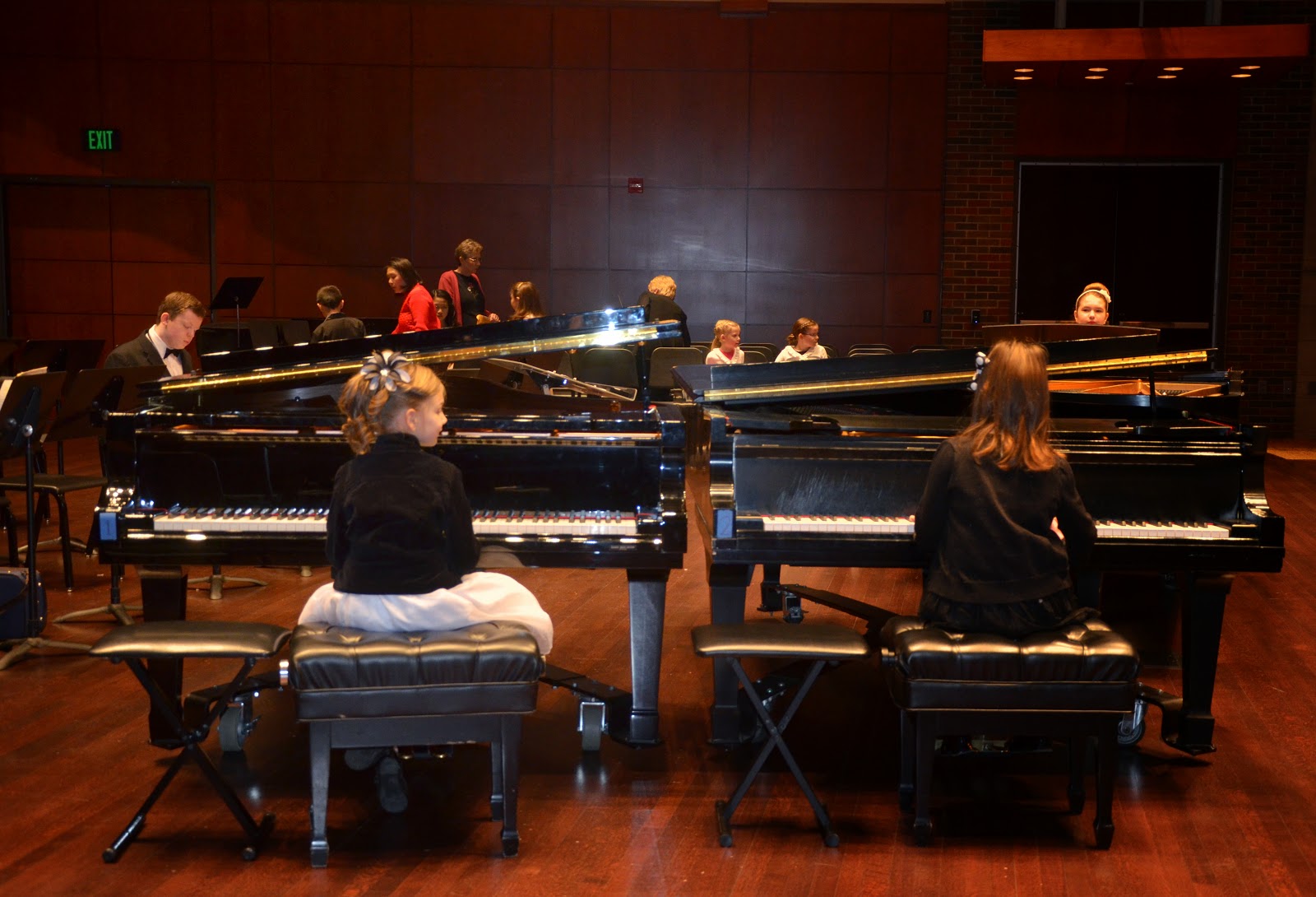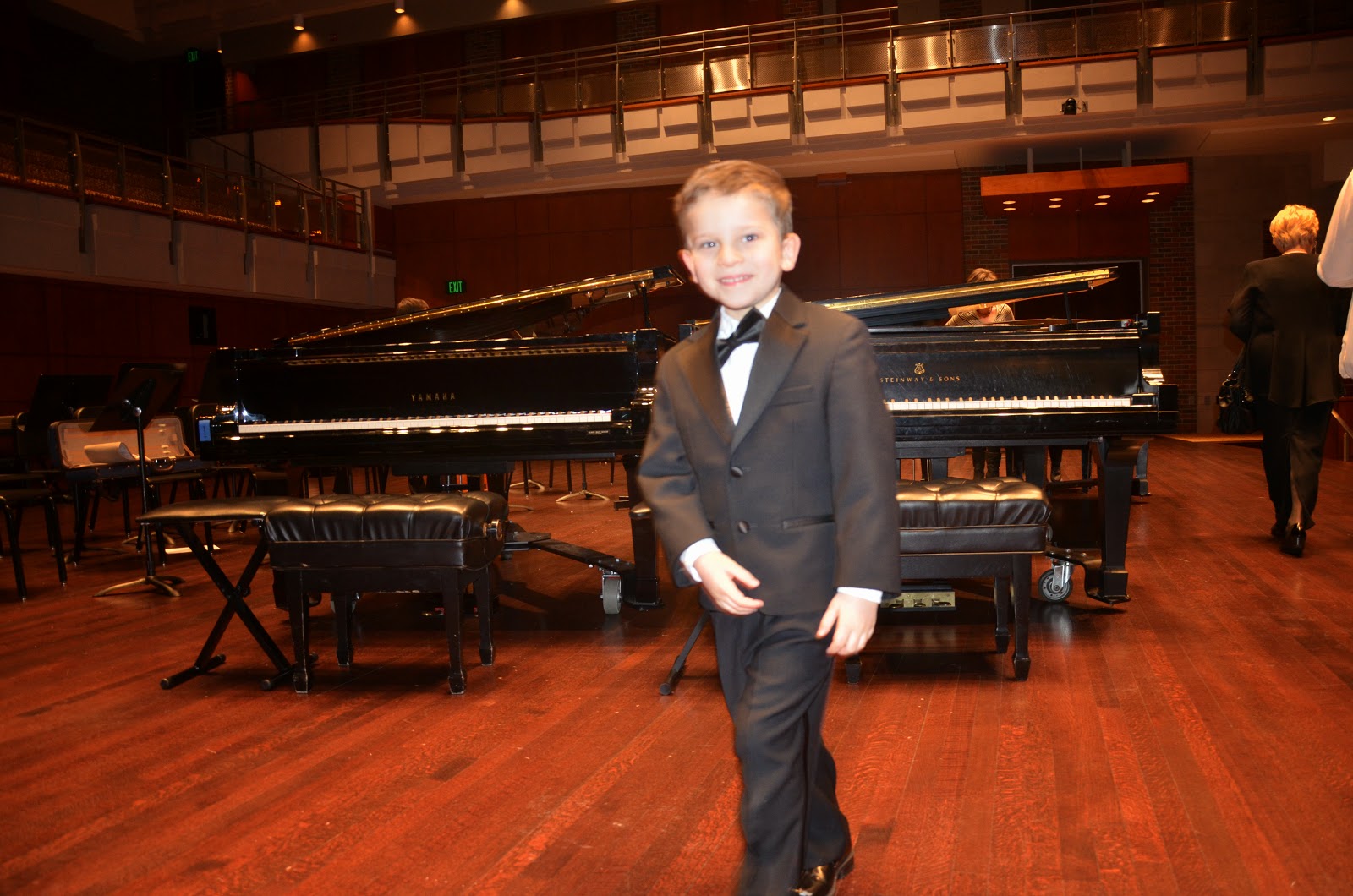-->
Our family’s usual conniving-for-a-snack-from-the-vending-machine went on as we experienced the rest of the concert together, now as audience members for the middle and high school performers. As we held out for the refreshments at the end of the concert, Mike and I were both highly impressed with the execution and musicality of the kids who performed. It confirmed our decision to keep the kids in a Suzuki curriculum for their music education. It nudged me to want to become Suzuki certified as a piano teacher and get back to playing my J.S. Bach Inventions and Beethoven Sonatas from college. Reading the bios in the program of the students who accomplished the National Piano Guild Auditions annually, and received the Sonatina Awards reminded me of years of my own “shivering inside,” as Naomi puts it, and great enjoyment and accomplishments. The light in parents’ eyes after the concert, some having never seen anything like this before, and some crowding around their senior in their final performance, was life giving. We are a part of this community together, building each other up from the infants up. The little cries and whimpers throughout the concert, I gladly excuse, because the parents are doing the best thing possible. Giving their babies an opportunity to listen, learn, and be a part of all of us.
David is jumping on the couch and flopping off, throwing
pillows. You would never know that
just a few hours ago he was decked out in a size 4 tuxedo, black bow tie,
playing Twinkle Twinkle Little Star on a Steinway concert grand piano, accompanied
by a string quartet.
The stage at the concert was set with three grand pianos,
rows of young performers on stage left and right, and professional musicians
from the community. As groups of
children went up in queue they performed the timeless Suzuki pieces with poise,
skill, and musicality. Naomi’s
group quickly followed David’s, with three girls, between 6 and 8 years old playing
Lightly Row. The three grands with
six little hands resounded together perfectly, big smiles and a triple bow at
the end. Applause.
The little fingers commanding the Yamaha and Steinway keys
drew me back to the years of lessons and performances I had throughout my
childhood, and drew me forward to a future for these kids, giving them solid
foundations for learning. The Suzuki
method is teaching their minds how to learn, how to memorize, how to present
themselves in front of hundreds of people, but most importantly, developing a
love for music. It is happening so
young, that by the time they are in their “tweens” it will be second nature. It offers children a community
where they can meet up with their best friends, reap the rewards diligent
practice, and learn who they are inside, at a soul level, as they forget about
notes and rhythms.
I was grateful to take in all the signs of life: the shaky
fingers of nerves, serious looks of concentration, the uprightness of the
performers about to go on, and the relaxed posture of a performer who sits
after he has just taken the bow. I
was enamored with the stage presence of the middle school students, playing
sonatas and concertos, and the elegance and poise of the high school student
who performed Saint-Saens concerto, in a sky blue gown.
Mike and I were discussing over a date at Cork and Fork last
night, that everyone in the concert, from the three year olds to the high
school seniors met the expectations set before them. The bar was raised, and
even Naomi and David, who sometimes--well, frequently--do what we call
sandbagging (e.g. I can’t. I don’t
remember. I have no idea how to play that), probably just looked around and
stepped up to the norm around them. Amazing what “normal” becomes when “normal” is at a very high
standard. Granted, David began walking towards the piano on his heels. Sat down at the 8 foot Steinway and
said, “I don’t think I can play Go Tell Aunt Rhody” in a shy cheeky whisper. Now,
the previous student had just played that, but he is supposed to play Twinkle! Redirect! “You’re playing Twinkle, let’s put your fingers here,” I
said. We looked up at his teacher
conducting the strings, and his little fingers calmly, gently, and accurately played
Twinkle Theme. As I was sitting next to him, with the sharpie mark on his left
hand and a fingernail I forgot to cut, I had one eye go blurry from a
tear. The tear escaped my eye and
probably glistened on my cheek as the final notes would play, How I wonder what you are. He lifted his
hands off the keys properly, hopped off the piano bench, shuffled his way to
the other boy performing with him, and they met up to bow together. At this point I was trying not to lose
it and very grateful the audience is focused on the little guys. But so what, it is reality. Parents cry when their kids do great
things and this is just the beginning.
Sitting on stage with the younger performers for Part 1 of the program, I could hear the humming, singing, and tapping fingers all around, as each group performed. Life was real. A child will not ask, “When is this over?” when he or she is surrounded by understanding and familiarity. In a generation where we are so quick to hand over the iPad to keep the children quiet, watching their friends perform the pieces they have been listening to for 6 months in the car on the way to school gave our kids an opportunity to relate, and really hear and feel the music. I can see that they are now equipped to listen at a concert, at least the pieces in Book 1, with depth.
Sitting on stage with the younger performers for Part 1 of the program, I could hear the humming, singing, and tapping fingers all around, as each group performed. Life was real. A child will not ask, “When is this over?” when he or she is surrounded by understanding and familiarity. In a generation where we are so quick to hand over the iPad to keep the children quiet, watching their friends perform the pieces they have been listening to for 6 months in the car on the way to school gave our kids an opportunity to relate, and really hear and feel the music. I can see that they are now equipped to listen at a concert, at least the pieces in Book 1, with depth.
Our family’s usual conniving-for-a-snack-from-the-vending-machine went on as we experienced the rest of the concert together, now as audience members for the middle and high school performers. As we held out for the refreshments at the end of the concert, Mike and I were both highly impressed with the execution and musicality of the kids who performed. It confirmed our decision to keep the kids in a Suzuki curriculum for their music education. It nudged me to want to become Suzuki certified as a piano teacher and get back to playing my J.S. Bach Inventions and Beethoven Sonatas from college. Reading the bios in the program of the students who accomplished the National Piano Guild Auditions annually, and received the Sonatina Awards reminded me of years of my own “shivering inside,” as Naomi puts it, and great enjoyment and accomplishments. The light in parents’ eyes after the concert, some having never seen anything like this before, and some crowding around their senior in their final performance, was life giving. We are a part of this community together, building each other up from the infants up. The little cries and whimpers throughout the concert, I gladly excuse, because the parents are doing the best thing possible. Giving their babies an opportunity to listen, learn, and be a part of all of us.
As comments flourish around moms outside of the Suzuki communities,
I hear things like, “my kid can’t do that, playing an instrument is just for
smart kids, and there’s just no way.” I stand by Dr.
Suzuki’s philosophy, “Every child
can.”
Suzuki Resources:



Comments
Post a Comment